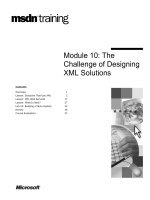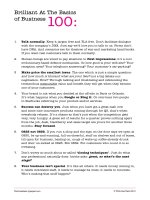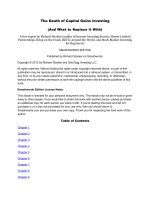FM11 Ch 10 The Basics of Capital Budgeting_Evaluating Cash Flows
Bạn đang xem bản rút gọn của tài liệu. Xem và tải ngay bản đầy đủ của tài liệu tại đây (138.05 KB, 56 trang )
10 - 1
Chapter 10:
The Basics of Capital Budgeting:
Evaluating Cash Flows
Overview and “vocabulary”
Methods
Payback, discounted payback
NPV
IRR, MIRR
Profitability Index
Unequal lives
Economic life
10 - 2
What is capital budgeting?
Analysis of potential projects.
Long-term decisions; involve large
expenditures.
Very important to firm’s future.
10 - 3
Steps in Capital Budgeting
Estimate cash flows (inflows &
outflows).
Assess risk of cash flows.
Determine r = WACC for project.
Evaluate cash flows.
10 - 4
What is the difference between
independent and mutually exclusive
projects?
Projects are:
independent, if the cash flows of
one are unaffected by the
acceptance of the other.
mutually exclusive, if the cash flows
of one can be adversely impacted
by the acceptance of the other.
10 - 5
What is the payback period?
The number of years required to
recover a project’s cost,
or how long does it take to get the
business’s money back?
10 - 6
Payback for Franchise L
(Long: Most CFs in out years)
10 8060
0 1 2 3
-100
=
CF
t
Cumulative -100 -90 -30 50
Payback
L
2 + 30/80 = 2.375 years
0
100
2.4
10 - 7
Franchise S (Short: CFs come quickly)
70 2050
0 1 2 3
-100CF
t
Cumulative -100 -30 20 40
Payback
S
1 + 30/50 = 1.6 years
100
0
1.6
=
10 - 8
Strengths of Payback:
1. Provides an indication of a
project’s risk and liquidity.
2. Easy to calculate and understand.
Weaknesses of Payback:
1. Ignores the TVM.
2. Ignores CFs occurring after the
payback period.
10 - 9
10 8060
0 1 2 3
CF
t
Cumulative -100 -90.91 -41.32 18.79
Discounted
payback
2 + 41.32/60.11 = 2.7 yrs
Discounted Payback: Uses discounted
rather than raw CFs.
PVCF
t
-100
-100
10%
9.09 49.59 60.11
=
Recover invest. + cap. costs in 2.7 yrs.
10 - 10
( )
.
1
0
t
t
n
t
r
CF
NPV
+
=
∑
=
NPV: Sum of the PVs of inflows and
outflows.
Cost often is CF
0
and is negative.
( )
.
1
0
1
CF
r
CF
NPV
t
t
n
t
−
+
=
∑
=
10 - 11
What’s Franchise L’s NPV?
10 8060
0 1 2 3
10%
Project L:
-100.00
9.09
49.59
60.11
18.79 = NPV
L
NPV
S
= $19.98.
10 - 12
Calculator Solution
Enter in CFLO for L:
-100
10
60
80
10
CF
0
CF
1
NPV
CF
2
CF
3
I
= 18.78 = NPV
L
10 - 13
Rationale for the NPV Method
NPV = PV inflows - Cost
= Net gain in wealth.
Accept project if NPV > 0.
Choose between mutually
exclusive projects on basis of
higher NPV. Adds most value.
10 - 14
Using NPV method, which franchise(s)
should be accepted?
If Franchise S and L are
mutually exclusive, accept S
because NPV
s
> NPV
L
.
If S & L are independent,
accept both; NPV > 0.
10 - 15
Internal Rate of Return: IRR
0 1 2 3
CF
0
CF
1
CF
2
CF
3
Cost Inflows
IRR is the discount rate that forces
PV inflows = cost. This is the same
as forcing NPV = 0.
10 - 16
( )
.
1
0
NPV
r
CF
t
t
n
t
=
+
∑
=
( )
t
n
t
t
CF
IRR
=
∑
+
=
0
1
0.
NPV: Enter r, solve for NPV.
IRR: Enter NPV = 0, solve for IRR.
10 - 17
What’s Franchise L’s IRR?
10 8060
0 1 2 3
IRR = ?
-100.00
PV
3
PV
2
PV
1
0 = NPV
Enter CFs in CFLO, then press IRR:
IRR
L
= 18.13%. IRR
S
= 23.56%.
10 - 18
40 40 40
0 1 2 3
IRR = ?
Find IRR if CFs are constant:
-100
Or, with CFLO, enter CFs and press
IRR = 9.70%.
3 -100 40 0
9.70%
N I/YR PV PMT FV
INPUTS
OUTPUT
10 - 19
Rationale for the IRR Method
If IRR > WACC, then the project’s
rate of return is greater than its
cost some return is left over to
boost stockholders’ returns.
Example: WACC = 10%, IRR = 15%.
Profitable.
10 - 20
Decisions on Projects S and L per IRR
If S and L are independent, accept
both. IRRs > r = 10%.
If S and L are mutually exclusive,
accept S because IRR
S
> IRR
L
.
10 - 21
Construct NPV Profiles
Enter CFs in CFLO and find NPV
L
and
NPV
S
at different discount rates:
r
0
5
10
15
20
NPV
L
50
33
19
7
NPV
S
40
29
20
12
5
(4)
10 - 22
-10
0
10
20
30
40
50
60
0 5 10 15 20 23.6
NPV ($)
Discount Rate (%)
IRR
L
= 18.1%
IRR
S
= 23.6%
Crossover
Point = 8.7%
r
0
5
10
15
20
NPV
L
50
33
19
7
(4)
NPV
S
40
29
20
12
5
S
L
10 - 23
NPV and IRR always lead to the same
accept/reject decision for independent
projects:
r > IRR
and NPV < 0.
Reject.
NPV ($)
r (%)
IRR
IRR > r
and NPV > 0
Accept.
10 - 24
Mutually Exclusive Projects
r 8.7 r
NPV
%
IRR
S
IRR
L
L
S
r < 8.7: NPV
L
> NPV
S
, IRR
S
> IRR
L
CONFLICT
r > 8.7: NPV
S
> NPV
L
, IRR
S
> IRR
L
NO CONFLICT
10 - 25
To Find the Crossover Rate
1. Find cash flow differences between the
projects. See data at beginning of the
case.
2. Enter these differences in CFLO register,
then press IRR. Crossover rate = 8.68%,
rounded to 8.7%.
3. Can subtract S from L or vice versa, but
better to have first CF negative.
4. If profiles don’t cross, one project
dominates the other.









